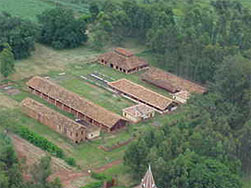 In this area we see where the animal were kept, the structure was planned to collect manure from the animals. The first building is where they ground food for the animals. In the basement there was an engine that by means of leather straps and pulleys, set the machines in motion, exactly the same process used to run the machines at the coffee processing shed. In the stables they kept mares to breed donkeys and mules (traction power at the time, today substituted by tractors). There were about 40 mares of pure race, big an strong, crossed with asses, produced strong and resistant donkeys and mules for the work in the fields.
In this area we see where the animal were kept, the structure was planned to collect manure from the animals. The first building is where they ground food for the animals. In the basement there was an engine that by means of leather straps and pulleys, set the machines in motion, exactly the same process used to run the machines at the coffee processing shed. In the stables they kept mares to breed donkeys and mules (traction power at the time, today substituted by tractors). There were about 40 mares of pure race, big an strong, crossed with asses, produced strong and resistant donkeys and mules for the work in the fields.
The corral, the calf's shed and the manure shed are all in the same complex. There are two wells, one was always being filled up while the other was being used. The reason for this is that manure has that to be tanned, before being used. By the size of the manure shed's structure we can see how important manure was at a time where there was no fertilizer and the coffee was so valuable that any effort to increase its productivity was well worth it. The roof is double because of gases, especially methane, which is dangerous if stored because it can be set on fire easily. One notices that, despite the concern with the ventilation, the roof burnt and part of it had to be remade.